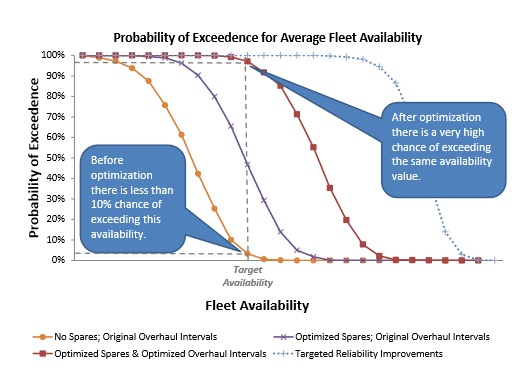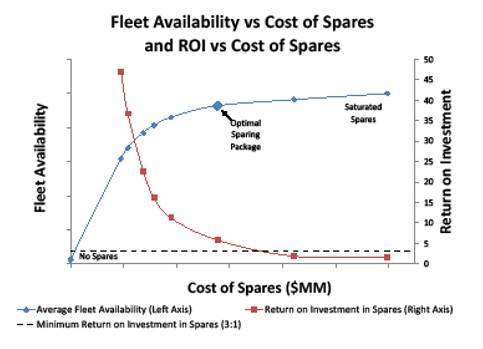Case Study: Drillship Fleet Performance Modeling
Clockwork identifies $2 billion in Increased Revenue When Optimally Investing $120 Million in Critical Capital Spares
A world leader in offshore drilling contracted Clockwork to create a high fidelity drillship fleet Reliability, Availability and Maintainability (RAM) Model, to optimize overhaul intervals for critical drillship equipment & investments in drillship capital spares.
The Challenge
At the highest breakdown level, each drillship in the fleet consists of a hull, drilling equipment, power generation equipment, a thruster system, and subsea equipment.
Each of these subsystems consists of various types of equipment which either they wear out over time and thus may require period overhauls or they are items or which capital spare replacements could be stocked, if economical, or both.
To complicate matters, a complex network of repair and overhaul locations support repair and spare parts routing when doing so is a cheaper option than waiting for a spare to become available through other means.

The Solution
In order to realistically quantify and forecast the future reliability and cost of a drillship fleet, Clockwork built a RAM model which captures the key details of the fleet’s ship configuration, operational profiles, and logistics network. The model captures, in detail, the critical equipment within the drillship fleet, their interrelationships, their reliability and maintainability as individual pieces of equipment, and their impact on the ability of the fleet to fulfill its operational requirements. A forecast for the expected availability of the drillship fleet considering both planned and unplanned downtime is then made available and explicitly links the availability or unavailability of critical capital spares to fleet availability by simulating the operations of the drillships over time, including: their drilling operations in well campaigns, planned surveys and overhaul events, stock levels of critical spares, planned and unplanned demands which deplete that stock, and equipment repair and overhaul cycles which return removed items to serviceable condition.
A time-dependent schedule of operations during a typical well campaign was then developed. A reliability block diagram specific to each operational profile to logically express which set of equipment within each of the five major subsystems and what configuration of that equipment must be operational in order to successfully complete each operational profile. Capturing this type of realistic detail about availability drivers is important because the key to optimizing both maintenance frequency and capital spares expenditures is determining the correct balancing point between increased fleet revenue through increased drillship availability and increased cost of spares and/or maintenance.
Capital Spares Optimization
The objective for the capital spares optimization was to purchase those spares which would maximize average ship availability across the drillship fleet, while achieving a ratio of revenue gain to spares cost of no less than 3:1. The optimization process started with
simulating the two boundary conditions – no spares and “infinite” spares. The fleet simulation with no spares provides a lower bound on fleet performance, while the fleet simulation with infinite spares provides an upper bound on fleet performance and on
spares costs.
The next step in the process was to utilize the model output metrics from the no spares run to determine the most economical set of spares to add next. Model outputs include measures of how much downtime each type of equipment is causing, both for unplanned failures and for planned equipment overhaul. For each subsequent simulation, when fleet availability increased as a result of spares reducing drillship planned and unplanned downtime, this translated directly into increased revenue.
Management wanted to determine whether their current practice of performing most major equipment overhauls on a five year schedule was economically optimal. They suspected that if some equipment were overhauled more frequently they would have a net savings from reduced unplanned costs and that if some other equipment were overhauled less frequently they would have a net savings from reduced overhaul costs.
The drillship fleet DESIGN PRO model was used to analyze a range of equipment overhaul scenarios, to formulate the optimum overhaul interval for each equipment type, based on both cost and availability, and independent of other constraints. Utilizing the optimal overhaul periods for each piece of equipment calculated by the model and considering how overhauls can be scheduled to best fit into the unavoidable downtime of required class inspections, an overhaul plan was recommended that included each equipment’s overhaul interval.

Value
• The optimized equipment overhaul intervals have an expected total cost
of $10.5 million less over 15 years per drillship.
• By applying a high fidelity RAM model to systematically optimize the right quantity
and mix of capital spares, the recommended sparing plans achieve an availability gain of 15% for the least cost, about $120 million
over a 15 year period. This results in approximately $2 billion in increased revenue for the fleet.
• Another key finding of this project was that adequately staggering planned overhauls across the fleet will avoid purchasing an
additional $16 million in spare equipment.
About Clockwork: Clockwork is a global leader of predictive analytics for Enterprise Asset Management (EAM) solutions that improve availability and reduce maintenance costs of capital intensive assets. With over 30 customers, the company provides cutting edge solutions that analyze asset data, provide performance visibility to each phase of an asset’s life cycle, resulting in increased availability, improved utilization, and billions worth of cost savings and profitability.
More about Plant Asset Management Strategy
For more information about predictive maintenance solutions, visit www.clockwork-solutions.com.
 Serg Posadas is the VP of Industry Solutions at Clockwork Solutions. He brings depth of experience to Clockwork in technical and strategic leadership. Serg has been with Clockwork for eight years following a 22-yr Marine Corps career. He applied predictive analytics and data science in his career as an aviator and operations analyst.
Serg Posadas is the VP of Industry Solutions at Clockwork Solutions. He brings depth of experience to Clockwork in technical and strategic leadership. Serg has been with Clockwork for eight years following a 22-yr Marine Corps career. He applied predictive analytics and data science in his career as an aviator and operations analyst.
Sorry, the comment form is closed at this time.




Pingback: CASE STUDY: Drillship Fleet Performance Modeling | Premium apps reviews Blog and Programing